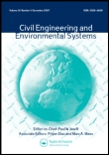
CIVIL ENGINEERING AND ENVIRONMENTAL SYSTEMS
Scope & Guideline
Elevating Research in Civil and Environmental Systems
Introduction
Aims and Scopes
- Systems Thinking and Analysis:
The journal promotes a systems-oriented approach to civil engineering, encouraging interdisciplinary perspectives that integrate various components of engineering, environmental science, and social factors. - Sustainability and Resilience:
A core focus is on developing sustainable practices and enhancing the resilience of infrastructure systems against environmental challenges, including climate change and natural disasters. - Innovative Methodologies:
The journal publishes research utilizing cutting-edge methodologies such as machine learning, Bayesian networks, and multi-criteria decision analysis to tackle contemporary engineering problems. - Safety and Risk Management:
Research on safety assessments, risk management strategies, and the reliability of structural systems is central to the journal's aims, addressing critical issues in civil engineering. - Public Policy and Ethical Frameworks:
There is an emphasis on exploring the implications of civil engineering decisions on public policy and ethical considerations, promoting responsible engineering practices.
Trending and Emerging
- Integration of AI and Machine Learning:
The increasing use of artificial intelligence and machine learning techniques in civil engineering research reflects a trend towards data-driven approaches for predictive modeling and decision-making. - Focus on Climate Change Adaptation:
Research addressing climate change impacts, resilience planning, and adaptive strategies for infrastructure is gaining prominence, reflecting the urgent need for sustainable solutions. - Interdisciplinary Collaborations:
There is a growing trend towards interdisciplinary collaborations that combine insights from engineering, environmental science, and social sciences to address complex systemic challenges. - Systems Approaches to Infrastructure Resilience:
An emphasis on systems approaches to enhance the resilience of urban infrastructure systems against disasters and environmental stressors is emerging as a significant theme. - Ethics and Public Policy in Engineering:
There is an increasing focus on the ethical implications of engineering practices and the role of civil engineers in shaping public policy and sustainability frameworks.
Declining or Waning
- Traditional Structural Analysis:
There appears to be a diminishing focus on conventional structural analysis methods, as the journal increasingly favors innovative approaches and systems thinking over traditional models. - Local and Context-Specific Studies:
Research that solely emphasizes local contexts without broader implications or systems perspectives is less prevalent, suggesting a shift towards more generalized, scalable solutions. - Single-Disciplinary Approaches:
There is a noticeable decrease in papers that approach civil engineering challenges from a purely disciplinary lens, as the journal moves towards more interdisciplinary frameworks.
Similar Journals
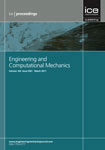
Proceedings of the Institution of Civil Engineers-Engineering and Computational Mechanics
Transforming Ideas into Engineering RealitiesProceedings of the Institution of Civil Engineers - Engineering and Computational Mechanics is a prestigious journal published by Emerald Group Publishing Ltd, dedicated to advancing the fields of civil and structural engineering, as well as mechanics of materials. With an ISSN of 1755-0777 and E-ISSN 1755-0785, this journal serves as a critical platform for disseminating innovative research and practical insights from 2009 through 2024. As part of its commitment to academic rigor, it is categorized in the Q4 quartile for both civil and structural engineering and mechanics of materials, reflecting a unique position in the scholarly community. The journal is essential for professionals, researchers, and students aiming to stay informed on current trends, methodologies, and applications in engineering and computational mechanics. By engaging with this publication, readers gain access to crucial findings that contribute to the advancement of infrastructure and materials science, vital for developing resilient and sustainable engineering solutions.
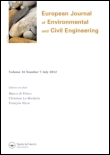
European Journal of Environmental and Civil Engineering
Bridging the Gap Between Engineering and Environmental StewardshipThe European Journal of Environmental and Civil Engineering, published by Taylor & Francis Ltd, is a prestigious peer-reviewed journal that serves as a vital platform for advancing knowledge in the fields of Civil and Structural Engineering as well as Environmental Engineering. With an impressive impact factor and categorized in the Q2 quartile for both engineering fields, this journal occupies a significant position in the scholarly community. Its focused scope encompasses innovative research, case studies, and practical applications that address contemporary environmental and infrastructural challenges. Researchers, professionals, and students alike benefit from the journal's commitment to high-quality discourse, as evidenced by its Scopus rankings, which place it in the top 30% in Civil and Structural Engineering and the top 40% in Environmental Engineering. Through the publication of cutting-edge studies and a commitment to fostering interdisciplinary dialogue, the European Journal of Environmental and Civil Engineering remains an essential resource for those dedicated to improving our built environment and safeguarding our natural resources.

CANADIAN JOURNAL OF CIVIL ENGINEERING
Building the Future Through Research and DevelopmentCanadian Journal of Civil Engineering, published by Canadian Science Publishing, serves as a premier platform for the dissemination of innovative research and development in the fields of civil and structural engineering, as well as environmental science. Established in 1971, this journal maintains a robust reputation, achieving a Q3 ranking in both civil engineering and general environmental science categories as of 2023. While it does not currently offer open access, the journal is accessible to a wide audience of researchers, professionals, and students who are keen to stay abreast of the latest advancements in civil engineering practices. With a significant number of yearly publications and a committed editorial board, the Canadian Journal of Civil Engineering contributes to the foundational knowledge and practical applications in the engineering community, thereby playing a critical role in addressing contemporary challenges in civil infrastructure and environmental sustainability.
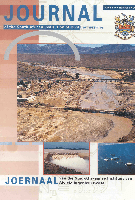
Journal of the South African Institution of Civil Engineering
Transforming ideas into engineering excellence.Journal of the South African Institution of Civil Engineering (ISSN: 1021-2019) is a distinguished open-access publication dedicated to advancing the field of civil engineering in South Africa and beyond. Established by the South African Institution of Civil Engineering (SAICE) and South African Institute of Steel Construction (SAISI), it serves as a critical platform for sharing research, case studies, and industry developments. The journal has been openly accessible since 2015, ensuring broader dissemination of knowledge among researchers, professionals, and students alike. Although it currently holds a Q4 ranking in Civil and Structural Engineering and is positioned within the lower percentiles in Scopus rankings, its commitment to fostering growth in the engineering sector remains strong. Covering various topics from structural design to innovative construction methodologies, the journal invites contributions that push the boundaries of current practices and methodologies. This publication is essential for those invested in sustainable engineering solutions, aiming to collaborate and contribute towards the evolution of civil engineering standards in South Africa.

International Journal of Management Science and Engineering Management
Advancing Management Science for Tomorrow's Engineering ChallengesInternational Journal of Management Science and Engineering Management, published by Taylor & Francis Ltd, serves as a vital platform for researchers, professionals, and students focused on advancing the fields of management science and engineering management. With an ISSN of 1750-9653 and an E-ISSN of 1750-9661, this journal has established a strong reputation for quality and relevance, reflected in its impressive impact factor and robust ranking across multiple categories including Q1 in Engineering (miscellaneous) and Mechanical Engineering, and Q2 in Management Science, Operations Research, and Strategy. Operating from the heart of the UK, International Journal of Management Science and Engineering Management occupies a significant niche, offering insights and methodologies that drive effective decision-making in today's complex landscapes. Furthermore, the journal's convergence from 2006 to 2024 demonstrates its commitment to ongoing research and innovation in the management domain, making it an essential resource for anyone invested in harnessing management science to solve contemporary engineering challenges.
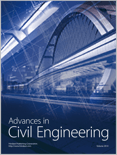
Advances in Civil Engineering
Shaping Tomorrow's Civil Engineering TodayAdvances in Civil Engineering is a leading peer-reviewed journal published by HINDAWI LTD, dedicated to advancing knowledge and innovation in the field of civil and structural engineering. Holding an esteemed Q2 ranking in the 2023 category for Civil and Structural Engineering, this journal serves as a vital platform for disseminating cutting-edge research and practical applications that address contemporary challenges in infrastructure development, sustainable design, and material science. Launched in 2008 and operating as an Open Access journal since 2009, it promotes the free exchange of ideas by ensuring that all articles are accessible to researchers, professionals, and students globally. The journal is also indexed in Scopus, ranking at #142 out of 379 in its category, situating it within the 62nd percentile of its peers. With a focus on interdisciplinary collaboration and innovative solutions, Advances in Civil Engineering contributes significantly to the ongoing evolution of engineering practices and education, making it an essential resource for anyone involved in or studying the ever-evolving field of civil engineering.
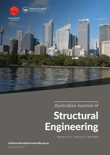
Australian Journal of Structural Engineering
Advancing Structural Innovation for a Sustainable FutureThe Australian Journal of Structural Engineering (ISSN: 1328-7982, E-ISSN: 2204-2261), published by TAYLOR & FRANCIS AS, serves as a pivotal platform for disseminating high-quality research in the fields of civil and structural engineering, mechanical engineering, and mechanics of materials. With a publications timeline from 2008 to 2024, this journal plays a crucial role in advancing knowledge and practice within its disciplines, boasting Q3 rankings across various categories as of 2023. Although it operates under a subscription model, the journal remains accessible to a diverse audience, including researchers, professionals, and students, seeking to enrich their understanding and engagement with contemporary engineering challenges. The Australian Journal of Structural Engineering is not only a repository of innovative ideas but also a vital resource for fostering collaboration and sparking discussion among scholars and practitioners striving for excellence in engineering design and analysis.

KSCE Journal of Civil Engineering
Transforming Ideas into Engineering ExcellenceKSCE Journal of Civil Engineering is a prestigious international publication dedicated to advancing the field of civil engineering. Established by the Korean Society of Civil Engineers (KSCE), this journal serves as a vital platform for high-quality research in the discipline, showcasing innovative methodologies, case studies, and critical analyses pertinent to civil and structural engineering. With an impact factor placing it in the Q2 category of civil engineering journals for 2023 and a solid Scopus rank of #141 out of 379, it reflects the significant contributions of its authors and the growing recognition of its published works. KSCE Journal of Civil Engineering, based in Germany and easily accessible to the global research community, is committed to disseminating knowledge with rigor and integrity, encouraging both emerging scholars and seasoned experts to contribute to the evolving discourse in civil engineering. With a convergence period from 2009 to 2024, the journal continues to uphold its mission of fostering innovation and excellence in engineering practice.

Journal of Transportation Engineering Part A-Systems
Transforming Ideas into Sustainable Transportation SolutionsThe Journal of Transportation Engineering Part A-Systems, published by the American Society of Civil Engineers (ASCE), is a cutting-edge, peer-reviewed journal dedicated to the advancement of knowledge in the field of transportation systems. With an ISSN of 2473-2907 and an E-ISSN of 2473-2893, this journal serves as a crucial resource for researchers, professionals, and students interested in the intricate interplay between civil engineering and transportation networks. Boasting a Q2 ranking in both the Civil and Structural Engineering and Transportation categories, this journal reflects the high-quality research contributing to these vital disciplines. Accessible through open-access options, the journal provides a platform for innovative ideas and research findings from 2017 to 2024, aiming to address contemporary challenges in transportation systems while fostering interdisciplinary collaboration. As an essential outlet for scholarly work in the United States and beyond, the Journal of Transportation Engineering Part A-Systems is committed to enhancing the understanding of complex transportation dynamics and the development of sustainable and efficient infrastructures.
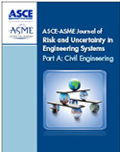
ASCE-ASME Journal of Risk and Uncertainty in Engineering Systems Part A-Civil Engineering
Empowering Civil Engineering Through Insightful Analysis.ASCE-ASME Journal of Risk and Uncertainty in Engineering Systems Part A-Civil Engineering, published by the American Society of Civil Engineers (ASCE), is a leading journal dedicated to advancing the understanding and application of risk and uncertainty in civil engineering systems. With an ISSN of 2376-7642, this journal has been a pivotal platform for researchers and practitioners since its inception in 2015, converging its rigorous exploration through to 2024. It holds a commendable position in the academic community, securing a Q2 rating in categories such as Building and Construction, Civil and Structural Engineering, and Safety, Risk, Reliability and Quality as of 2023. The journal aims to disseminate innovative research that tackles the critical challenges posed by uncertainty in engineering systems, thus promoting safety, sustainability, and reliability in infrastructure. With impressive Scopus rankings, including a 76th percentile in Building and Construction, it continues to attract high-quality contributions from scholars worldwide. Emphasizing open dialogue, the journal does not currently adopt an open access model but remains committed to providing essential insights for the enhancement of civil engineering practices. Researchers, professionals, and students alike will find invaluable resources to enhance their knowledge and practice in this dynamic field.